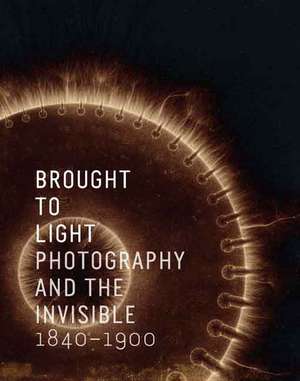Brought to Light: Photography and the Invisible, 1840-1900
Editat de Corey Keller Contribuţii de Jennifer Tucker, Tom Gunning, Maren Gröning, Marie-Sophie Corcy, Carole Troufléau-Sandrin, Erin O'Tooleen Limba Engleză Hardback – 25 noi 2008
A fascinating look at photography’s impact on science and popular culture
Brought to Light invites readers to step back to a time when photography, X-rays, and movies were new, when forays into the world beneath the skin or the realm beyond our everyday vision captivated scientists and the public alike. In this book, accounts of scientific experimentation blend with stories of showmanship to reveal how developments in 19th-century technology could enlighten as well as frighten and amaze. Through a series of 200 vintage images—produced by photographers, scientists, and amateur inventors—this book ultimately traces the rise of popular science.
The images demonstrate early experiments with microscopes, telescopes, electricity and magnetism, motion studies, X-rays and radiation, and spirit photography. We learn how these pictures circulated among the public, whether through the press, world’s fairs, or theaters. What started out as scientific progress, however, often took on the trappings of magic and superstition, as photography was enlisted to offer visual evidence of clairvoyance, spirits, and other occult influences.
With beautifully reproduced plates and engaging narratives, this book embodies the aesthetic pleasures and excitement of the tale it tells.
Brought to Light invites readers to step back to a time when photography, X-rays, and movies were new, when forays into the world beneath the skin or the realm beyond our everyday vision captivated scientists and the public alike. In this book, accounts of scientific experimentation blend with stories of showmanship to reveal how developments in 19th-century technology could enlighten as well as frighten and amaze. Through a series of 200 vintage images—produced by photographers, scientists, and amateur inventors—this book ultimately traces the rise of popular science.
The images demonstrate early experiments with microscopes, telescopes, electricity and magnetism, motion studies, X-rays and radiation, and spirit photography. We learn how these pictures circulated among the public, whether through the press, world’s fairs, or theaters. What started out as scientific progress, however, often took on the trappings of magic and superstition, as photography was enlisted to offer visual evidence of clairvoyance, spirits, and other occult influences.
With beautifully reproduced plates and engaging narratives, this book embodies the aesthetic pleasures and excitement of the tale it tells.
Published in association with the San Francisco Museum of Modern Art
Exhibition Schedule:
San Francisco Museum of Modern Art (October 11, 2008 – January 4, 2009)
Albertina Museum, Vienna (March 20 – June 6, 2009)
Preț: 356.67 lei
Preț vechi: 380.48 lei
-6% Nou
Puncte Express: 535
Preț estimativ în valută:
68.26€ • 69.90$ • 56.78£
68.26€ • 69.90$ • 56.78£
Comandă specială
Livrare economică 04-18 martie
Doresc să fiu notificat când acest titlu va fi disponibil:
Se trimite...
Preluare comenzi: 021 569.72.76
Specificații
ISBN-13: 9780300142105
ISBN-10: 0300142102
Pagini: 216
Ilustrații: 207 color illus.
Dimensiuni: 241 x 298 x 27 mm
Greutate: 1.63 kg
Editura: Yale University Press
Colecția Yale University Press
ISBN-10: 0300142102
Pagini: 216
Ilustrații: 207 color illus.
Dimensiuni: 241 x 298 x 27 mm
Greutate: 1.63 kg
Editura: Yale University Press
Colecția Yale University Press
Notă biografică
Corey Keller is associate curator of photography at the San Francisco Museum of Modern Art. Jennifer Tucker is associate professor of History at Wesleyan University. Tom Gunning is professor of Art History at the University of Chicago.
Maren Gröning is Curator of the Photographic Collection at the Albertina Museum, Vienna.
Recenzii
"[This catalog] unearths rare 19th-century scientific prints, everything from an x-ray of a snake digesting a frog to pictures of electricity that could have been taken in Dr. Frankenstein's lab."—Richard B. Woodward, Wall Street Journal
